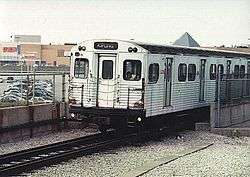M-series (Toronto subway)
| M-series | |
|---|---|
|
An M-series train at the Greenwood Subway Yard | |
| Manufacturer | Montreal Locomotive Works |
| Built at | Montreal, Quebec |
| Constructed | 1961–1962 [1] |
| Entered service | 1962 |
| Scrapped | May 1999 [1] |
| Number built | 36 |
| Number in service | None |
| Number preserved | 2 (owned by private museum) [1] |
| Number scrapped | 34 |
| Formation | 2 car mated pairs (operated as 3 pair (6 car) trains) |
| Fleet numbers | 5300–5335 |
| Capacity | 83 (formerly 84) seated |
| Operator(s) | Toronto Transit Commission |
| Line(s) served |
Yonge–University–Spadina line Bloor–Danforth line |
| Specifications | |
| Car body construction | Aluminum |
| Car length | 23.012 m (75 ft 6.0 in) |
| Width | 3.14 m (10 ft 4 in) |
| Height | 3.65 m (12 ft 0 in) |
| Floor height | 1.1 m (3 ft 7 in) |
| Doors | 8 sets (4 sets per side) per car |
| Maximum speed | 89 km/h (55 mph) |
| Weight | 27,215 kg (60,000 lb) |
| Traction motors | DC |
| Power output | 120 hp (89 kW) |
| Auxiliaries | None (?) |
| Electric system(s) | 600 V DC Third rail |
| Current collection method | Contact shoe |
| Braking system(s) | Westinghouse Brake & Signal Co. digital electro-pneumatic braking and Electro-dynamic reheostatic service brake |
| Track gauge | 4 ft 10 7⁄8 in (1,495 mm) |
The M-series, also known as M1, was a rolling stock of rapid transit trains used in the Toronto subway system. They were built by Montreal Locomotive Works in Montreal, Quebec, Canada in 1961-62.
History
By 1960, the Toronto Transit Commission was preparing to expand its subway system to include the University line. The TTC wanted subway cars with a larger 75-foot (22.86 m) design and also wished to expand upon some of the experimental features in the existing G-Series cars.[2] The new design was pushed forward by GM John G. Inglis.
A total of only 36 M-series cars were built. As the subway expanded and more vehicles were necessary, the TTC turned to Hawker Siddeley to build the next series of subway cars.
Design
The TTC performed testing at St. Clair and Union stations with a 75-foot test vehicle known as the Duncan Dragon. Built at the Duncan Shops by Len Bardsley and the D&D Equipment, the test car consisted of two trucks with three panels and was designed to test the size of train that could successfully navigate the tunnels. A steel girder with railings allowed workers to walk and ride the car during tests.
After specifications for the new cars were finalized, Alco's Montreal Locomotive Works was contracted to build the new cars, dubbed "M1".[1] The cars are historically notable as the first Canadian-built subway cars[2] and, at the time of their construction, were the longest subway cars in the world.[1]
All subsequent TTC cars have followed the size and length specifications of the M-series (though the Toronto Rocket deviates from the 2 car married pair formation) and influenced several other transit authorities to examine the use of longer cars.
Retirement
The M1 trains were decommissioned and scrapped in 1999, with cars 5300 & 5301 given to the Halton County Radial Railway museum for preservation.[1]
Gallery
 An M-series train in service on the Bloor–Danforth line
An M-series train in service on the Bloor–Danforth line
External links
References
- 1 2 3 4 5 6 "Halton County Radial Railway: Collection Roster". Halton County Radial Railway. 2010. Retrieved 2010-01-15.
- 1 2 Aaron Adel and James Bow, revised by Robert Lubinski (2006). "The Montreal Series (M-1) Cars (1963-1999)". Transit Toronto.


_(14918534190).jpg)